History of the Grapevine Scholastic (School) Census, 1901-1970

Genealogists are well-versed in the use of federal census records to identify and document their ancestors, but did you know that school districts also made headcounts of their students? This blog is about the history of scholastic census taking in Grapevine.
HISTORY OF THE SCHOLASTIC CENSUS IN TEXAS
Scholastic census records document the counting of school age children by counties and districts so the state could apportion funds for their education. The first census of Texas school-age children was mandated by an act passed by the Fifth Texas Legislature, Regular Session, on 31 January 1854. From 1854-1905, annual censuses of school children were conducted in each county by its county tax assessor’s office.
The law required that a list of the free white population between the age of six and eighteen years be made each year in every county. The age was lowered to six and sixteen in 1870. In 1884 the census began to include all children in the county between the ages of eight and sixteen. In 1895, the scholastic census would be conducted between the first day of May and the first day of June for all children over eight and under seventeen on the first day of the following September. In 1925 the age requirement was changed to between seven and eighteen. Finally in 1929, the law changed the age to six through eighteen, which remained in effect until 1975, when the scholastic census was abolished.
In 1905, responsibility for census taking was transferred to the newly-created office of county superintendent of schools. From 1905-1969, the county superintendent’s office compiled and sent a consolidated census roll to the Texas State Board of Education and filed a copy with the county clerk. The original individual enumerated census forms were retained by the county superintendent of schools. After 1969, copies of the rolls were no longer required to be filed with the county clerk. In 1989, custody of all scholastic census records in county custody was transferred to the Texas State Library and Archives Commission by the Local Government Records Act. School districts thus had the option of turning census records over to the commission for historic preservation.
THE SCHOLASTIC CENSUS IN GRAPEVINE
An election was held on 7 April 1906 to determine if Grapevine should incorporate itself for free school purposes only. The bond issue passed. Over time, several additions were made to the original Grapevine Independent School District (GISD) plat map, shown below. As an independent school district, GISD has its own taxing authority independent of the city, county, and state. GISD records are a part of the Tarrant County scholastic censuses. The records consist of the cumulative report by the enumerator, known as a census trustee, followed by individual census forms listing the name and number of the school district, name of parent or guardian, and the name, address, birth date, age, sex, and any physical handicaps for each child. The enumerator was to be a trustee of the school district or another qualified person. The earliest available census for the GISD was taken during the 1919-1920 school year by I. W. Weatherly, who enumerated four hundred five white children and twenty-one “colored” children. Black children were enumerated separately throughout all enumerations, but with the same information, through the 1969-1970 school year.
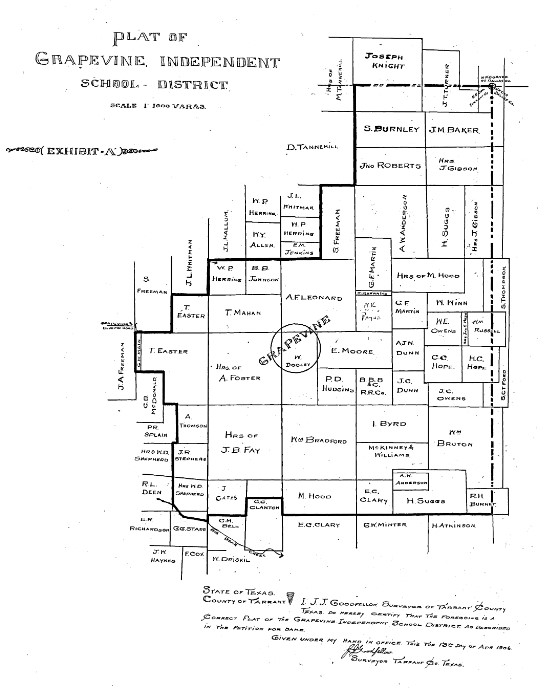
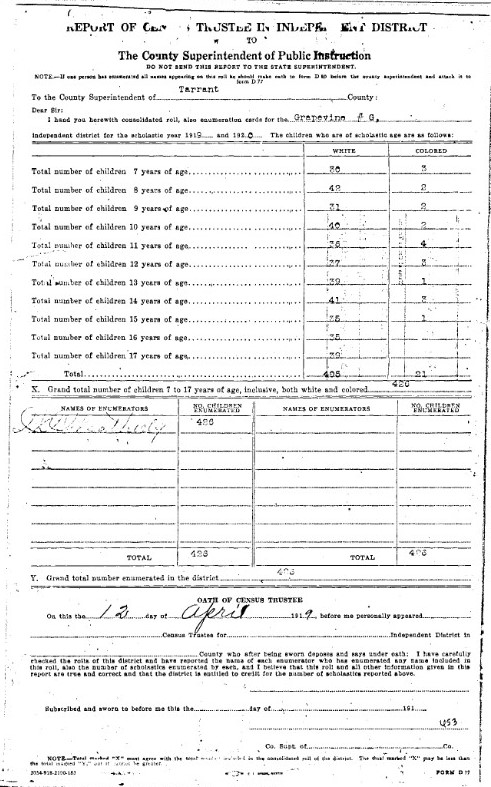
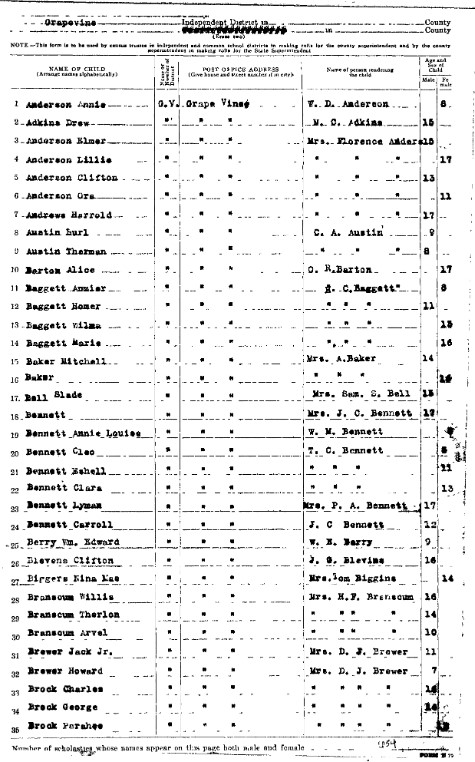
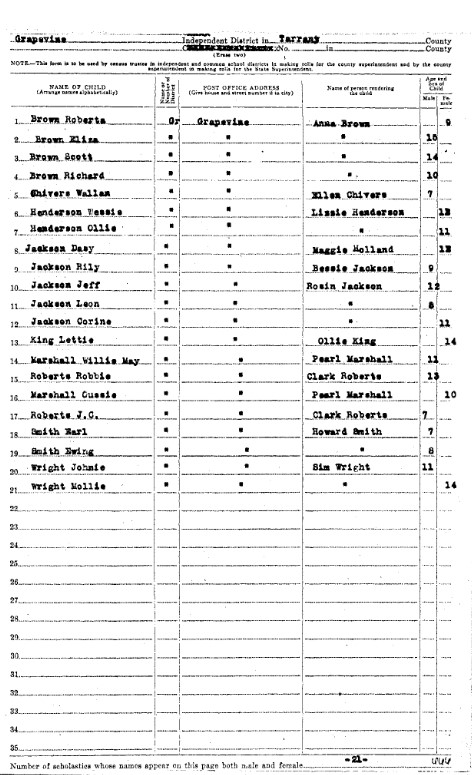
Enumerators recorded information on pre-printed forms, called “Family Census Blanks.” They included the school district name, number, and county; name of each child between the ages of six and eighteen in each household; birth date, sex, and age for each enumerated child; handicap, if any; name of the county in which the family lived in the preceding census year; how long the family had lived in the school district for which the census was being taken; nationality of the family; names of the father and mother; signature of the parent, guardian or person responsible for the child or children; address of the family and/or child; name of the farm the family and/or child lived on, if living on a farm; signature of the census trustee; and the date the information was recorded. As far as is known, such cards are not available for Tarrant Co., but the example from McLennan Co. in 1930 below demonstrates how the typical census card was filled out.
Information from the cards was extracted and recorded on consolidated census sheets. Records are incomplete, and some years are missing. Consolidated sheets do not identify individual schools within the district.
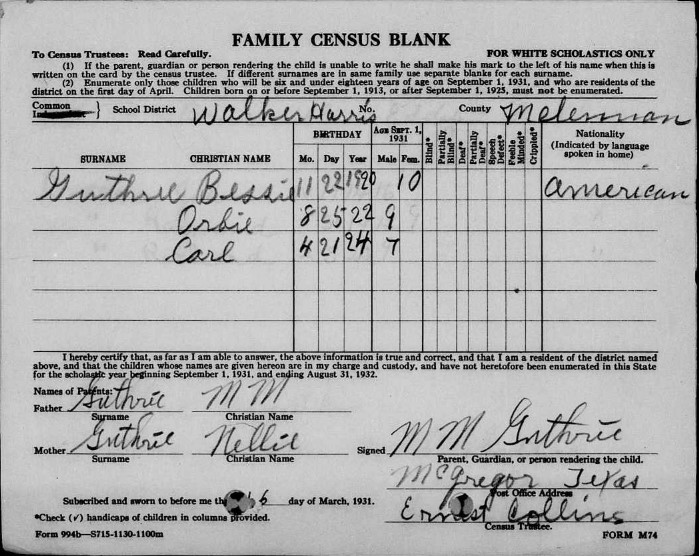
Enumerators had thirty days to tally all eligible children. An inaccurate or incomplete census meant that the school district would lose funds for the upcoming school year, so the district superintendent placed announcements in the Grapevine Sun to remind parents and guardians to respond to the enumerator when he or she called on them.
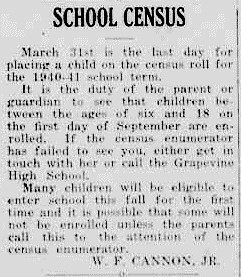
Prior to 1915, the scholastic census was taken in May. Beginning in 1916, it was taken in March, and from 1954-1969, it was taken in January. GISD also budgeted money from its maintenance fund for expenses incurred during school census-taking. For example, the 1911-1912 audit reveals that $13.04 was disbursed for census taking, and $3.26 for making census rolls.
The school system has been augmented several times by the consolidation of smaller outlying school districts. The Pleasant Glade School joined the GISD on 3 October 1936. The Miller School followed on 30 August 1939, and Minter’s Chapel School was consolidated on 10 June 1948. Pleasant Run School was consolidated after 24 February 1962, when Grapevine and Colleyville voters elected to combine their schools into the Grapevine-Colleyville ISD (GCISD). This was done in order to provide a higher quality education for a lesser cost than either district could provide on its own.
Anecdotes from for census trustees reveal a “slice of life” during enumeration periods. During the time he was taking the 1902 census, Professor J. R. Smith of the Grapevine Public School observed that mothers could tell him the exact ages of their children, while fathers had to either stop and think a minute or consult the family record.
Mary Virginia Wall (later Simmons) was the longest-serving enumerator; in 1932, 1933, 1945, and from 1953-1975, and taught school as well. Her mother, Beulah (Estill) Wall, had been a census trustee from 1925-1930. Mary Virginia recalled walking almost the entire boundary of the district in the early days and driving very little except to a few “far-flung” places within the district. That changed, of course, as more schools were taken into the GISD. In the early days an enumerator did not have to visit every home because the community was small enough that residents knew each other and who their children were; a neighbor could give information about the family next door and it would be accepted. Mary Virginia had counted three hundred school-age children in 1932; she was paid ten cents per child listed and earned $30.
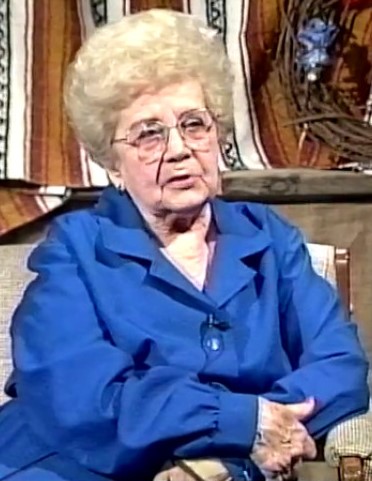
Mrs. Simmons recalled a couple of “funny experiences” she had as an enumerator. In one instance, she visited a Grapevine family whose children were born in Oklahoma, but the courthouse in that county had burned and they had no birth certificates to prove their ages. For six years she had to swear that the mother had given the correct birthdays; officials accepted this and gave the children birth certificates. On another occasion, there were children on the school rolls all through school with their step-father’s name, even though he hadn’t officially adopted them. In order to get their diplomas, they had to have their birth certificate names on them, so Mrs. Simmons also had to swear that for a certain number of years that the children’s mother had given her their first names with the step-father’s surname, but that their real name was such-and-such.
Gathering as much information for as long as Mrs. Simmons performed this task occasionally came in very handy. While substitute teaching one day, she called out a student by name who kept acting up, then proceeded to identify his siblings and parents by name, as well as his siblings’ birth dates. The student was awestruck that she knew all this, since she was “just a substitute,” and improved his behavior, lest his parents should find out.
In 1947, District Superintendent W. F. Cannon, Jr. reminded citizens that a married daughter or son under eighteen on September 1, 1947 also had to be enumerated. If any such individual was indeed married, he or she was not identified as such on the census roll. An Act of the state legislature in September 1969 mandated a fine of not less than five dollars but not more than ten dollars on any parent or guardian who refused to comply with the census trustee.
In November 1969, the state legislature required three enumerators to be appointed who would then take the census every five years instead of annually. In 2004, Mrs. Simmons recalled that the census had not been taken in the usual manner since 1975. This was because an Act of the Texas Legislature abolished the law requiring school censuses, effective in February of that year. The value of the enumeration had become “questionable,” and it was costing between three and five million dollars each time it was taken.
It is not known whether any Family Census Blanks still exist for Tarrant Co. schools. Beginning with the 1948-1949 GISD census, the consolidated census rolls were computerized instead of typed, and include the students first and last name, father or guardian’s name, school district number, and the month, day, and year of birth of the student instead or his or her age.
Copies of GISD/GCISD consolidated census rolls are available for viewing at Grapevine Public Library in the Genealogy Room. These and other Tarrant Co. school censuses can be viewed on the Tarrant County Archives web site.
If you can provide additional documented historical information relating to Grapevine school censuses (especially persons who took these headcounts), please contact Nancy Maxwell, Genealogy Librarian, Grapevine Public Library.
Following is a list of identified enumerators from 1901 – 1969-1970:
1901-1902, 1904 – Prof. J. R. Smith
1905 – Prof. L. K. Smith
1908 – J. N. Millican, J. R. McCain, Bransford; Wallace Estill, J. L. Millican, Pleasant Glade; S. J. Thomas, Minter’s, J. W. Thompson, S. I. Jones, Miller
1909 – S. J. Thomas, Minter’s; I. N. Daniels, Bransford; J. L. Millican, Pleasant Glade, J. T. Hollon, Miller
1910 – D. R. Vickers, Pleasant Run; John Roberts, Wallace Estill, Pleasant Glade; S. J. Thomas, Minter’s; J. T. Hollon, Miller
1911 – Wallace Estill, Pleasant Glade
1915 – Lee K. Davis, Dist. 8 (Miller); C. J. Parker, Dist. 29 (Pleasant Glade); E. G. Harris, Dist. 30 (Minter’s); S. J. Thomas, Grapevine Dist.
1916 – L. K. Davis, Miller; C. J. Parker, Pleasant Glade; E. G. Harris, Minter’s
1919 – W. C. Connally, Miller; I. N. Daniel, Pleasant Run; W. L. Estill, Pleasant Glade; J. C. McCormick, Minter’s; E. E. Higgins, Dist. 99; I. W. Weatherly, Grapevine
1920, 1922 – Frank Estill
1923 – O. R. Barton
1924 – Frank Estill
1925-1930 – Mrs. C. J. (Beulah Estill) Wall
1931 – C. J. Wall
1932-1933 – Mary Virginia Wall
1934 – Mrs. Kate (Bushong) Turnage
1935 – Mrs. Earl (Kate Estill) Yates
1937-1940 – Mrs. H. L. (Lula Faye Simmons) Higgins
1941-1944 – Mrs. Corbin (Nell Fields ) Crews
1945 – Mrs. Hugh (Mary Virginia Wall) Simmons
1946-1949 – Mrs. Corbin Crews (1946 census missing)
1950 – W. F. Cannon
1953-1966 – Mrs. Hugh Simmons
1967-1968 – Mrs. Hugh Simmons, Mrs. John Cody
1969 – Mary Virginia Simmons, Martha Cody, Betty Baker




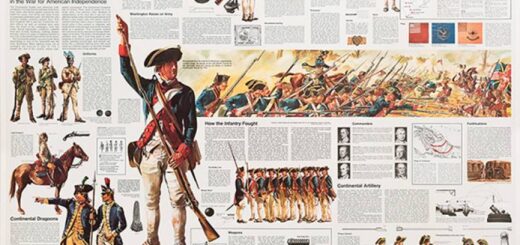
Recent Comments